
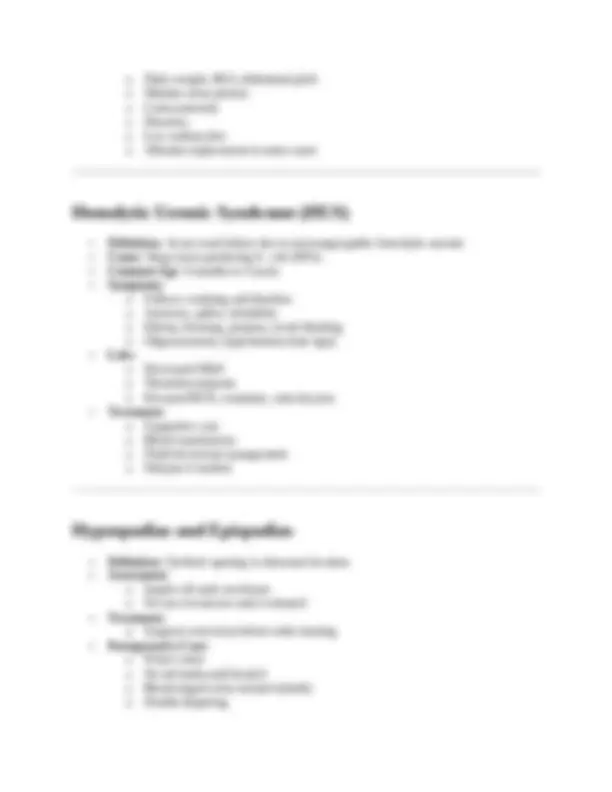
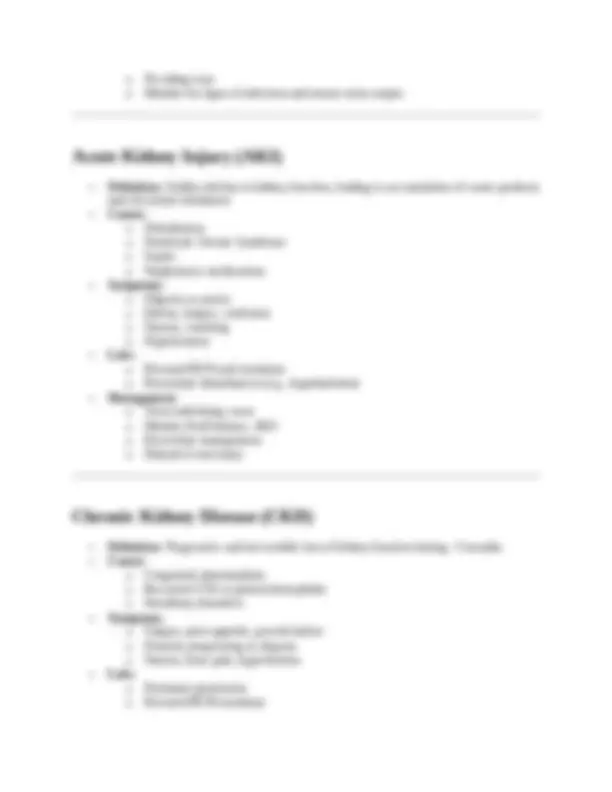
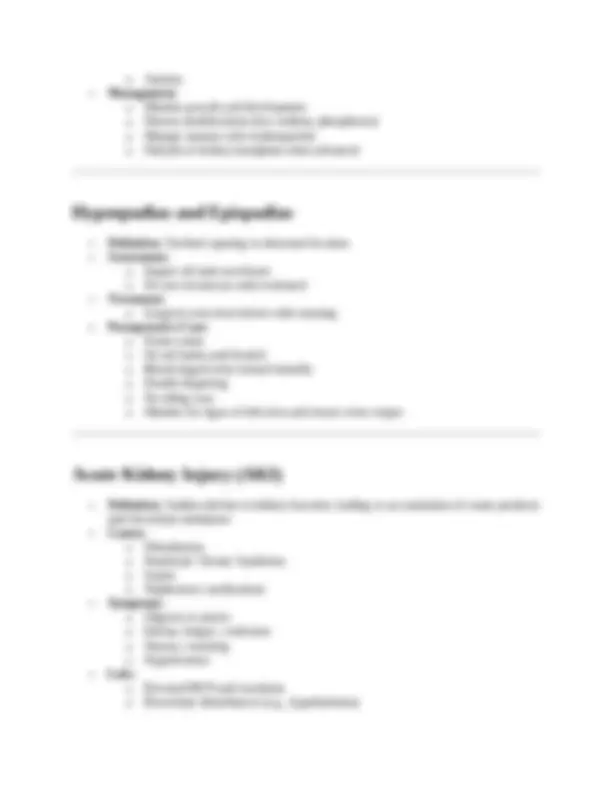
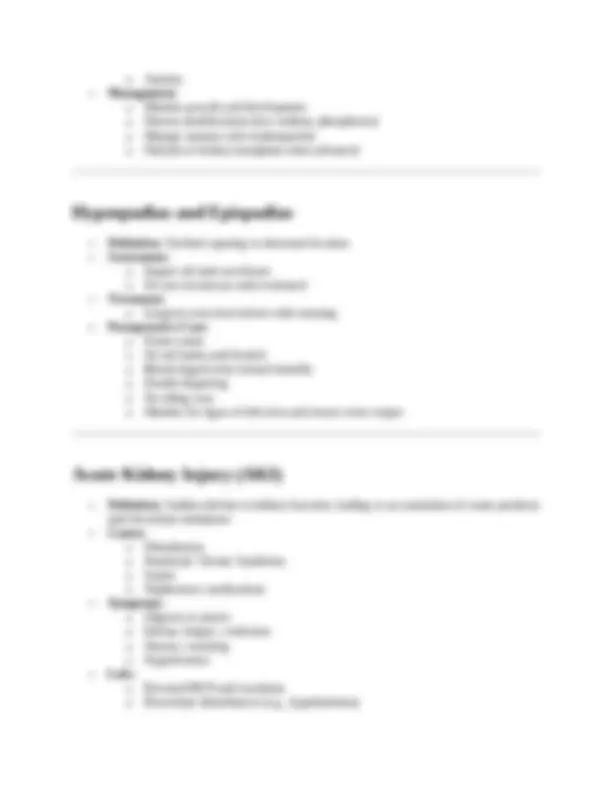
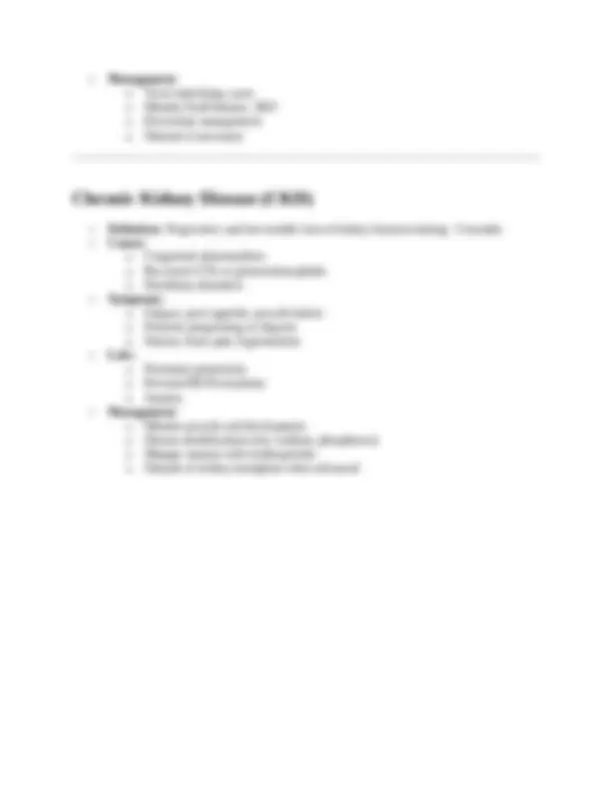


Study with the several resources on Docsity

Earn points by helping other students or get them with a premium plan


Prepare for your exams
Study with the several resources on Docsity

Earn points to download
Earn points by helping other students or get them with a premium plan
Community
Ask the community for help and clear up your study doubts
Discover the best universities in your country according to Docsity users
Free resources
Download our free guides on studying techniques, anxiety management strategies, and thesis advice from Docsity tutors
Renal system notes, study notes
Typology: Study notes
1 / 9

This page cannot be seen from the preview
Don't miss anything!






Function : Maintains fluid and electrolyte balance Organs : Kidneys, ureters, bladder, urethra Normal Urine Output : 0.5–2 mL/kg/hour Common Pediatric Concerns : High incidence in girls; frequent cause of hospitalization
Health History : UTI history, voiding patterns, recent infections Physical Exam : Abdominal palpation, edema, genital exam Medications : Antibiotics, anticholinergics, antispasmodics Procedures/Surgeries : Urologic history Hygiene : Front-to-back cleaning, toilet habits Toilet Training : Assess developmental stage Normal UA Values : o pH: 5– o Specific gravity: 1.001–1. o Protein: <20 mg/dL
Cause : Mostly E. coli (85%) Symptoms : o Abdominal or back pain o Nausea, vomiting o Foul-smelling urine o Urgency, frequency, incontinence o Fever (infants) Diagnosis : Urinalysis Treatment : o Antibiotics (start before culture returns) o Increase fluids o Eliminate constipation o Ensure hygiene and frequent voiding
o Use bladder scans to check retention Complications : Pyelonephritis , urosepsis
Definition : Retrograde urine flow from bladder to kidneys Risks : Familial pattern, recurrent UTIs Complications : Pyelonephritis, renal scarring Grades : I to V Management : o May resolve on its own o Prophylactic antibiotics o Surgical correction for severe cases (Grades IV–V)
Symptoms : o Facial/periorbital edema (morning) o Anorexia, lethargy, pallor o Oliguria, tea-colored urine, hematuria o Mild proteinuria, hypertension, headache Labs : o Positive ASLO titer o Elevated BUN & creatinine Management : o Treat strep if active o Monitor weight, I&O, neuro status o Antihypertensives o Low sodium diet, possible fluid restriction
Symptoms : o Generalized edema, weight gain o Periorbital/facial edema, ascites o Proteinuria, dark frothy urine o Hypoalbuminemia, normal BP Treatment :
o No riding toys o Monitor for signs of infection and ensure urine output
Definition : Sudden decline in kidney function, leading to accumulation of waste products and electrolyte imbalance Causes : o Dehydration o Hemolytic Uremic Syndrome o Sepsis o Nephrotoxic medications Symptoms : o Oliguria or anuria o Edema, fatigue, confusion o Nausea, vomiting o Hypertension Labs : o Elevated BUN and creatinine o Electrolyte disturbances (e.g., hyperkalemia) Management : o Treat underlying cause o Monitor fluid balance, I&O o Electrolyte management o Dialysis if necessary
Definition : Progressive and irreversible loss of kidney function lasting >3 months Causes : o Congenital abnormalities o Recurrent UTIs or glomerulonephritis o Hereditary disorders Symptoms : o Fatigue, poor appetite, growth failure o Polyuria progressing to oliguria o Nausea, bone pain, hypertension Labs : o Persistent proteinuria o Elevated BUN/creatinine
o Anemia Management : o Monitor growth and development o Dietary modifications (low sodium, phosphorus) o Manage anemia with erythropoietin o Dialysis or kidney transplant when advanced
Definition : Urethral opening in abnormal location Assessment : o Inspect all male newborns o Do not circumcise until evaluated Treatment : o Surgical correction before toilet training Postoperative Care : o Protect stent o No tub baths until healed o Blood-tinged urine normal initially o Double diapering o No riding toys o Monitor for signs of infection and ensure urine output
Definition : Sudden decline in kidney function, leading to accumulation of waste products and electrolyte imbalance Causes : o Dehydration o Hemolytic Uremic Syndrome o Sepsis o Nephrotoxic medications Symptoms : o Oliguria or anuria o Edema, fatigue, confusion o Nausea, vomiting o Hypertension Labs : o Elevated BUN and creatinine o Electrolyte disturbances (e.g., hyperkalemia)
o No riding toys o Monitor for signs of infection and ensure urine output
Definition : Sudden decline in kidney function, leading to accumulation of waste products and electrolyte imbalance Causes : o Dehydration o Hemolytic Uremic Syndrome o Sepsis o Nephrotoxic medications Symptoms : o Oliguria or anuria o Edema, fatigue, confusion o Nausea, vomiting o Hypertension Labs : o Elevated BUN and creatinine o Electrolyte disturbances (e.g., hyperkalemia) Management : o Treat underlying cause o Monitor fluid balance, I&O o Electrolyte management o Dialysis if necessary
Definition : Progressive and irreversible loss of kidney function lasting >3 months Causes : o Congenital abnormalities o Recurrent UTIs or glomerulonephritis o Hereditary disorders Symptoms : o Fatigue, poor appetite, growth failure o Polyuria progressing to oliguria o Nausea, bone pain, hypertension Labs : o Persistent proteinuria o Elevated BUN/creatinine
o Anemia Management : o Monitor growth and development o Dietary modifications (low sodium, phosphorus) o Manage anemia with erythropoietin o Dialysis or kidney transplant when advanced
Definition : Urethral opening in abnormal location Assessment : o Inspect all male newborns o Do not circumcise until evaluated Treatment : o Surgical correction before toilet training Postoperative Care : o Protect stent o No tub baths until healed o Blood-tinged urine normal initially o Double diapering o No riding toys o Monitor for signs of infection and ensure urine output
Definition : Sudden decline in kidney function, leading to accumulation of waste products and electrolyte imbalance Causes : o Dehydration o Hemolytic Uremic Syndrome o Sepsis o Nephrotoxic medications Symptoms : o Oliguria or anuria o Edema, fatigue, confusion o Nausea, vomiting o Hypertension Labs : o Elevated BUN and creatinine o Electrolyte disturbances (e.g., hyperkalemia)